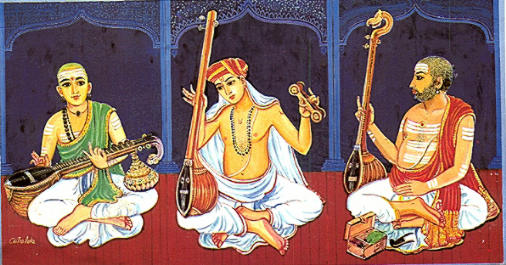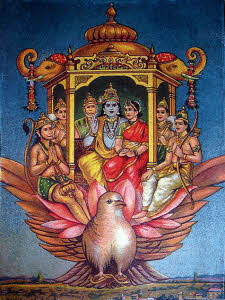by Suresh Subrahmanyan
I play the notes as they are written, but it is God who makes the music.
Johann Sebastian Bach.
At an educated guess, it is generally agreed that Carnatic music, as a performing art has been practiced for close to 130 years – give or take. The art form itself has evolved over that period, and the concert format that discerning audiences have come to widely appreciate, has been with us, alive and kicking, for over a century. The great doyen and performer par excellence, Ariyakudi Ramanuja Iyengar is credited with giving shape to this form of presentation at the turn of the 20th century, which has put down firm roots in the hearts and minds of Carnatic music lovers.
Interestingly, the major body of compositions that comprises the driving force of a Carnatic concert, was composed at least two to three hundred years ago. The revered trinity – Tyagaraja, Muttuswamy Dikshithar and Syama Sastry – and Purandaradasa before them, along with the likes of Swati Tirunal and a host of other composers of their ilk provide the magnificent body of work for performers to delve into. The compositions of these savants can keep a performing musician busy for more than one lifetime.
It would be axiomatic to state that all these composers have invoked religion, in all its varied hues, as the inspiration to guide their breathtaking efforts. In most cases, the composers have been only too happy to aver that their offerings were divinely mandated, and that they were merely humble vessels through which God, in His myriad avatars, decided to speak in various tongues – to say nothing of the sublime ragas in which these songs, or kritis, have been composed. When you listen to many of these compositions, understand their meaning, absorb yourself in the ragas meticulously assigned for each of the songs, you have to wonder if they were not right.
Which brings us to the nub of this essay. To the uninitiated, a typical performance or kutcheri, to give it its proper name, has two aspects to it. The compositions – varnams, kritis, padams, javalis, tillanas and so on being one part. The second is the vitally crucial improvisational aspect, consisting of raga alapanas, neravals, kalpana swaras and the crowning glory – the ragam, tanam, pallavi (RTP). These are the areas where each individual artist can display his or her prowess as a true exemplar of the art form. To borrow from the lexicon of fine art, the musician can display aspects of realism, impressionism, cubism and even modern art, depending on the innate instincts of the artist. The free flowing, untrammelled, stream of consciousness passages, may properly be considered the litmus test of a performer’s ability, style and individuality. It is what separates the wheat from the chaff and draws the crowds in.
Without wishing to play down the importance of the composition, the pre-determined, liturgical format of the songs must necessarily take a back seat to the improvisational aspect, which ultimately nails the mark of a musician’s unique imprint. There are those who will bristle at this suggestion, and if push comes to shove, one can be even handed about it. Happily, the performing art is not governed by some unseen theocratic power, that enjoins religion to be the primary raison d’etre for its very existence.
It is instructive to observe that, in the case of western classical music, the great symphonies and concertos are all fully notated, and the orchestra and the soloist follow the script to a T, under the watchful eye and baton of the conductor. Beethoven’s immortal 9th Symphony, or Bach’s 1st Brandenburg Concerto will sound pretty much the same irrespective of which orchestra or conductor is involved. In my music collection, I have three different recordings of Beethoven’s incandescent violin concerto in D, and I can’t tell the difference! I could be justifiably chastised for oversimplification. Evidently, there is something we, the less informed, do not know. The point only serves to illustrate the amount of elbow room and leeway that a Carnatic musician enjoys, to improvise within the confines of a strictly codified structure, as opposed to his western counterpart.
Then again, if one were to briefly examine the Hindustani system of classical music there is, relatively speaking, sparse lyrical content, and the audience’s enjoyment of the music depends almost entirely on the musician’s innate ability to interpret and present a khayal in say, raga Yaman in his own unique style that clearly distinguishes and mirrors his gharana. Primacy is given to the raga exploration in the Hindustani method, whereas in Carnatic music, the lyrical content of the composition and the exploration of the raga go head to head, and share equal space. Which perhaps explains why Carnatic music, for the most part, is essentially a vocal tradition.
Which brings us back to questioning our basic premise. Is the role of religion, as evidenced through its lyrical content, paramount to our understanding of Carnatic music? Can one propound the following dialectic, which asks if our appreciation will be any the less if the songs were composed in praise of the wonders of nature or a lover’s angst? After all, South Indian film songs have been composed in Carnatic ragas, describing calf love and even, day to day quotidian preoccupations. Will Kamboji or Kalyani be any the less palatable if the lyrics sang the praises of the moon in June? Are Rama, Krishna and Siva the only paths to internalizing the riches of our musical heritage? Let us not forget that Muttuswamy Dikshithar found inspiration in our planetary system while composing the radiant Navagraha kritis. However, the divine hand was never forsaken in his awe of the celestial wonders, expressed through those great compositions. References to Brahma, Vishnu, Shiva and their reincarnations or avatars, freely appear in this brilliant suite of songs. Nevertheless, there are those amongst Carnatic music lovers, who will tell you that lack of understanding the lyrics in the multi-lingual fare on offer, has never precluded their enjoyment of the music. After all, Pavarotti’s passionate rendering of Puccini’s monumental Nessun Dorma! moves us in ways that make the unintelligible Italian lyrics completely irrelevant. Music and lyrics – the two are mutually exclusive.
Going a step further, the late George Harrison of The Beatles Hare Rama-ed, Hare Krishna-ed and Halleleujah-ed his way to the top of the international pop charts with his driving, ecstatic My Sweet Lord in 1970. Not sure if the pubescent teenagers who swayed to the pulsating rythms of this hit, were high on religion or some other substance!
As an informed listener, what one seeks in a concert is predictable consistency from the artist, punctuated by periodic epiphanic or ‘aha’ moments. It’s rather like watching the comforting if somnolent, scenery whiz past from a speeding train window, and unexpectedly coming across a magnificent rainbow. You can’t have too many rainbows in a concert, but when it does appear, it sends shivers down the back of the neck. A frisson of excitement that cannot be adequately described in words, but you’ll know it when it happens to you – if you have music in your bones. It is also truly the sign of a great performer.
To conclude that there are arguments on both sides of the lyrical and improvisational divide, and that the jury is out, would be a futile exercise in dissembling. The truth is, without the inspired compositions of the great masters, there would have been no Carnatic music as we know and understand it. It is what it is, be it joyful or threnodic. That notwithstanding, we cannot praise too highly the great performing artists over the past 100 odd years, who took this wonderful body of work, added their own distinct stamp of genius, and provided music aficionados with what we continue to enjoy to this day as the kutcheri format.
Thank God for that.
Pic from indianmusic.weebly.com






